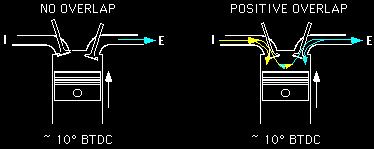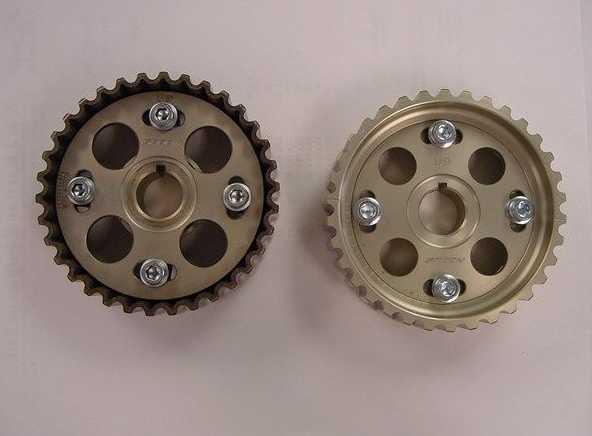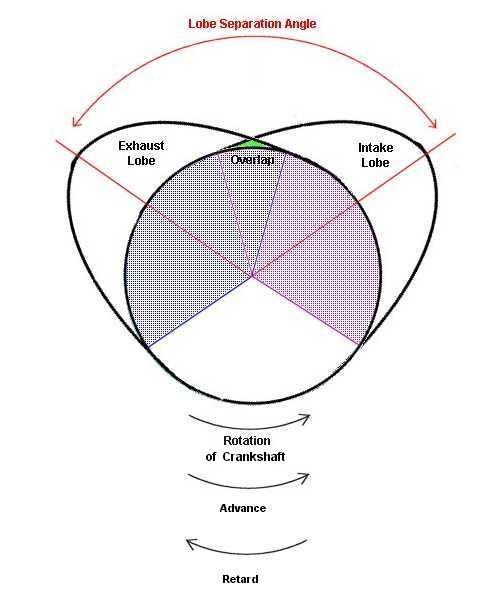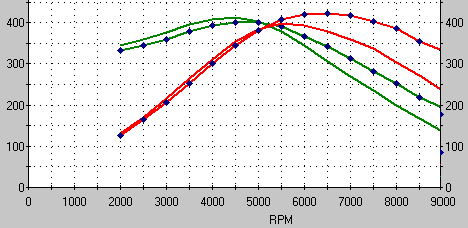| What's Hot! | Products/ Tools | EFI Tuning | Basic Tuning | Advanced Tuning | Chassis Tuning | Advertise with us |
Cam Gear Tuning
Contributed By: Unknown Submission
To shift or move the powerband up higher along the rpm range (for 1/4 mile et. improvement), you need to increase the overlap. You do this by tightening the lobe separation angle (LSA) between the intake cam's and exhaust cam's lobe centers with your aftermarket adjustable cam gears . When you tighten the LSA, you increase cam overlap duration.

If you want a higher powerband location, you tighten the LSA by rotating the intake and exhaust cam gears in opposite directions from one another in steady precise increments. The trick is to find the best overlap for your particular engine's package of parts and unique way of breathing compared to everyone else's.
EFFECT OF TIGHTENING THE LSA WITH ADJUSTABLE CAM GEARS
(Click for larger image)
FIGURE LEGEND
Hp and Torque Curves with Dots = Tighter LSA
Without Dots = Wider LSA
Wider lobe separation angle (no dots) produces more midrange torque but with a loss of upper rpm and peak torque. Narrower lobe separation angle (with dots) produces more high rpm range and peak torque but with a loss of midrange. Less LSA increases intake and exhaust valve opening overlap which creates more scavenging and a stronger upper rpm powerband. Less LSA [or more intake and exhaust cams overlap] is better for a racing engine than a high performance street engine. The idle suffers as you add more overlap since there's not enough vacuum at idle rpm.
SUMMARY OF THE EFFECTS OF TIGHTENING LSA
1. Moves Peak Torque to Higher RPM
2. Increases Maximum Torque
3. Narrows Powerband
4. Builds Higher Cylinder Pressure
5. Increase Chance of Engine Knock
6. Increase Cranking Compression and Effective Compression
7. Idle Vacuum is Reduced and Idle Quality Suffers
8. Open Valve-Overlap Increases
9. Closed Valve-Overlap Increases
10. Decreases Piston-to-Valve Clearance Obviously, widening the LSA (decreasing overlap) does the opposite to these.
Have you checked to make sure that INTAKE 0 degree and EXHAUST 0 degree markings on those cam gears were indeed set at TDC?
On a tuning session on the street or at the strip, I suggest that you do the cam gear tuning by going with a friend in the passenger seat with a stopwatch, if you don't have a datalogger that records speed and elapsed time. Do some wide open throttle acceleration runs at the 1/4 mile strip on a test & tune day. The point here is that , for each cam gear setting, do your timing over the exact same stretch of road and over the same exact distance. Have your friend time how long it takes you to go from say 30 mph to 90 mph. Do 2 runs for every setting. You want an objective measure ,like an acceleration time, to tell you if the setting is good for your particular engine. Acceration is the change in speed over the change in time. You want a higher number if the cam gear setting is good. A change of 1 tenth of a second or more consistently is good.
Don't rely on the butt dyno. It's only sensitive to changes in the early part of the rpm range.
Each person's engine will have a different optimal cam gear setting for it. Just because someone has the exact same model Integra and parts as you, does not necessarily mean that their engine and yours behave identically. Variations in performance can occur simply from minor differences in assembly at the factory, engine break-in procedures (if any) by the owner, and owner maintenance.
I would go 2 camshaft degrees at a time starting with the intake cam, since it also determines the reference baseline ignition timing as well (connected to the distributor) . Do 2 runs per setting over the same track distance. When you stop seeing an improvement in the elapsed time in between your 2 set mph points, then go back to the best setting. As for the "next best part" for your engine, I really don't think along those lines. I choose my powerband location and power goals first, and get parts that have designs or specs that will fascilitate getting those 2 goals.
An Enginebasics.com author would like to add:
While I don't have much experience with cam gear tuning on Naturally Asperated motors (N/A), I do have a lot with turbocharged motors. I have found that the EXACT OPPOSITE is true for a turbo motor as what is posted above. Adding more overlap in the lower RPM band aids in turbocharger spooling to the point that 300-400 rpm of quicker spool is easily noticed for HUGE mid-range torque gains. That overlap should be decrased substantially around peak torque, and then COMPLETLY REMOVED on the upper RPM bad to have ZERO overlap. Forced Induction motors don't like overlap on the upper RPM band since the air is being forced in, it will just be pushed in the intake and right back out the exhaust. Forced induction motors are actually hindered by the scavaging affect that can be prodeced by having cam overlap up top.
As you can see this is completly opposite to tuning an N/A motor. Also remember that the amount of overlap to have or not have will be based on the:
1. Cam Duration
2. Cam rise
3. Size of motor
Cam tuning is really something that can only be mastered on a dyno, but hopefully this article will give you a place to start depending on whether your motor is N/A, or FI.
You must have adjustable cam gears for your application to be able to make such adjustments:
***Remember*** to check for other relevant information in the columns and article tables
ATTENTION READER:
If you enjoyed the information and article you just read be sure to check out our newly released book with even more exciting photo's and information:How to Turbocharge and Tune your Engine

Want to know more about your particular Make and Model vehicle? All of these vehicles are covered in the tech, maintenance and repair articles found above. Enginebasics is the wiki or wikipedia of car part, repair, how to and tuning information. Let us be the class 101 for your automotive learning.
| Ford | General Motors GM | Pontiac | Jaguar | Land Rover | Nissan |
| Toyota | Honda | Lexus | Acura | Lotus | Scion |
| Infinity | BMW | Mercedes | Mitsubishi | Ferrari | Maserati |
| Lamborghini | Volks Wagen VW | Saab | Audi | Hyundai | Kia |
| Subaru | Mazda | Chevy | Volvo | Caddilac | Dodge |
| Chrylser | Daewoo | Porsche | Mercury | Freightliner | MG |
Individual Models
| Ford Mustang | Mitsubishi Eclipse | Mitsubishi Evo | Subaru WRX / STI | Dodge Viper | Chevrolet Corvette |
| Nissan Skyline | Honda S2000 | Nissan 350z | Toyota Supra | Chevy Camaro | Lotus Elise Exige |
| Honda Civic | VW Golf | Dodge SRT-4 | Eagle Talon | Acura Integra | BMW M3 |
| Nissan 240sx | Porsche 911 | Acura NSX | Honda Accord | Toyota Camry | Toyota MR2 |
| VW R32 | Dodge Truck | Mazda Rx7 | VW Jetta | Sand Buggy | Nissan Sentra |
For the latest Automotive news and stories visit the websites below |
Our feature Build: An AWD V6 Civic







